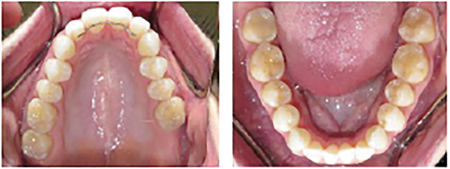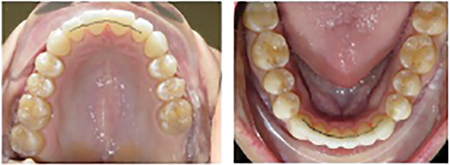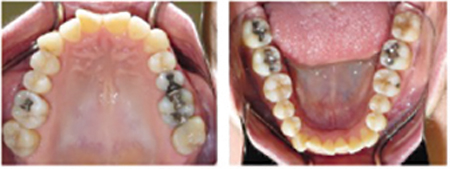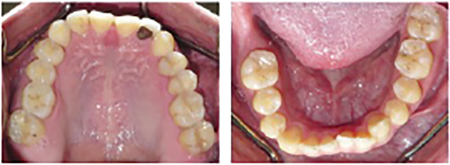The contemporary practice of orthodontics focuses not only on achieving ideal alignment and occlusion, but also on how the teeth relate to the soft tissues of the face. Smile arc is one of the most important factors when assessing and optimizing smile esthetics. In the pursuit of attaining a well-treated orthodontic case, the smile arc must be addressed.
SMILE ARC
The smile arc is defined as the relationship between the curvature of the maxillary anterior teeth relative to the curvature of the lower lip in the posed smile.1 An ideal smile arc has the contour of these teeth matching that of the lower lip. If these curvatures are parallel, the term consonant is used to describe this relationship. (Fig. 1A) A consonant smile arc is considered to be more attractive than a non-consonant smile. (Fig. 1B) With age, the smile arc generally flattens and when comparing gender differences, females tend to have a more pronounced curvature than males.2
Fig. 1A & 1B

Dental factors that influence the smile arc include arch form, arch width, the occlusal plane angle, crown lengths of the maxillary anterior teeth, and inclination of the maxillary incisors.1,3,4 Other habits and soft tissue factors that affect the smile arc are the lower lip curvature, thumb sucking and attrition.5
There are many studies in the literature that report on the esthetic preferences of lay people. Lay people can identify smile characteristics that both enhance and detract from a smile. Not surprisingly, it was found that smile arc is an important contributing factor to an attractive smile.6 A study done by Parekh and colleagues7 found that both orthodontists and lay people prefer smiles in which there is a consonant smile arc. Furthermore, it was reported that a non-consonant smile arc will significantly reduce the attractiveness of any male or female smile.8
OVERBITE CONSIDERATIONS
Overbite is defined as the amount of vertical overlap between the maxillary and mandibular incisors. An ideal overbite is generally quantified as 20-30% or 1-3mm. The concern with an improper overbite is that it can lead to significant tooth wear or chipping, difficulties with chewing, and challenges with speech.9,10,11 During orthodontic treatment, the smile arc can be unintentionally flattened in the pursuit of other treatment objectives. Therefore, when correcting overbite, the maxillary anterior tooth positions and how it affects the smile arc must be carefully monitored and accounted for.
INVISALIGN AND VERTICAL CONTROL
Advances in clear aligner therapy have allowed practitioners to utilize Invisalign as a comprehensive treatment modality to address complex malocclusions.
In the treatment of anterior open bites, aligners possess an advantage over traditional fixed appliances. Whereas braces tend to produce an extrusive effect on the posterior teeth and worsen the anterior open bite, Invisalign is able to control the vertical component of the posterior teeth. In fact, by nature of the plastic occlusal coverage over the teeth in combination with the patient’s normal masticatory forces, this helps to achieve posterior intrusion.12 With both maxillary and mandibular molar intrusion, counterclockwise rotation of the mandible generally follows. This further helps to correct the anterior open bite.
In addressing deep bite cases, the abovementioned principles make bite opening biomechanically very challenging. Therefore, careful attachment design and the use of bite ramps and elastics are required in order to elicit the desired vertical correction.
When working up the Invisalign Clincheck, it is recommended to plan the maxillary incisor position as they relate to the smile arc and then retro-engineer the other tooth movements accordingly.13 In preserving the smile arc and idealizing maxillary incisor display, deep bite correction is primarily achieved through intrusion of the mandibular incisors and canines. The incorporation of bite ramps is instrumental in facilitating this mandibular anterior intrusion.
CASE ILLUSTRATIONS
A review of significant overbite discrepancies and how they were corrected with the smile arc in mind are presented in the cases below.
CASE #1
The patient was a 30-year-old female seeking treatment to address the relapse that had occurred following orthodontic treatment as a teenager. She presented with a 3mm anterior open bite, a left side posterior crossbite, and maxillary arch constriction. The maxillary arch showed mild crowding and the mandibular arch showed moderate crowding. The patient had a very pronounced reverse smile arc. Her cephalometric radiograph revealed her palatal plane to be divergent from the mandibular plane angle and a deficient upper incisor show relative to the upper lip. (Fig. 2)
Case 1
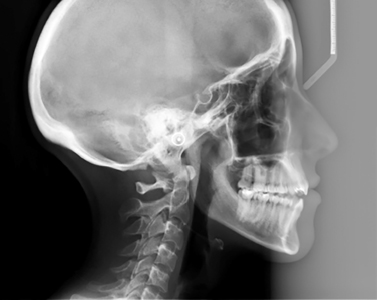
Fig. 2A-C
Fig 2D-E
The hyperdivergent skeletal pattern was indicative of surgical intervention; however, the patient declined surgery. Treatment consisted of Invisalign aligners with significant posterior intrusion and extrusion of both maxillary and mandibular anteriors. Judicious interproximal reduction of the mandibular anteriors was performed in order to preserve positive overjet. No intermaxillary elastics were required.(Fig. 3). Buccal corridors were reduced and more incisal show upon smiling with a consonant smile arc was achieved. (Fig. 4)
Fig. 3A-C
Fig. 3D-E
Fig. 4A-B
CASE #2
The patient was a 45-year-old female who presented for an initial orthodontic consultation with the desire to fix her bite and correct the crowding. She presented with a Class III subdivision left malocclusion and moderate maxillary and mandibular crowding. She had a lateral open bite on the right side and an edge-to-edge bite in the anterior that was causing wear on the incisors. Her initial presenting smile arc was flat. Similar to the previous case, the cephalometric radiograph revealed a superiorly tilted maxillary occlusal plane that was divergent from the mandibular occlusal plane. (Fig. 5)
Case 2

Fig. 5A-D
Fig. 5E-F
Treatment consisted of Invisalign aligners, interproximal reduction on the mandibular arch, and Class III elastics. The open bite was corrected through a combination of posterior intrusion and anterior extrusion. (Fig. 6) A nice improvement in her smile arc was achieved. (Fig. 7)
Fig. 6A-C

Fig. 6D-E

Fig. 7

CASE #3
The patient was a 25 year-old male with chief complaint of crowding and a deep overbite. The patient presented with a Class II malocclusion associated with mild bimaxillary anterior crowding. Both maxillary and mandibular archforms were irregular and square shaped. He had a deep impinging bite and canted anterior maxillary occlusal plane that contributed to a slanted smile arc. The cephalometric radiograph highlights his hypodivergent skeletal pattern. (Fig. 8)
Case 3
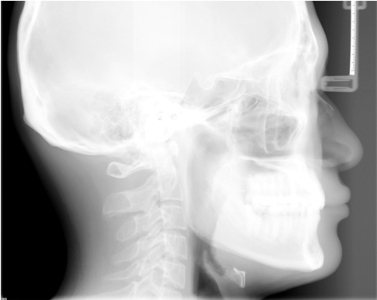
Fig. 8A-C
Fig. 8D-E
Treatment consisted of Invisalign aligners with expansion, proclination, and interproximal reduction performed on both arches. Bite ramps and Class II elastics were utilized. The deep bite and cant were resolved through leveling the mandibular curve of Spee with mandibular anterior intrusion, slight intrusion of the left maxillary anteriors, and extrusion of the right maxillary anteriors. (Fig. 9)
Fig. 9A-C

Fig. 9D-E
Correction of deep bites in non-growing patients is predominantly achieved through intrusion of the anterior teeth. This is because extrusion of the molars tends to be unstable and frequently relapses due to the fact that the muscles of mastication are unable to stretch. Therefore, in attempts to correct the deep bite through anterior intrusion, one must carefully consider how it will affect the smile arc aesthetics. Ultimately, an improved and symmetric consonant smile arc was achieved. (Fig. 10)
Fig. 10
CASE #4
The patient was a 27-year-old female who presented for an orthodontic consultation due to concerns of her deep bite and upper crowding. Initial records show a significant full cusp Class II Division 2 malocclusion with moderate maxillary crowding and mild mandibular crowding. A deep impinging overbite was causing excessive wear on the mandibular incisors. Both maxillary and mandibular archforms were constricted and box-like. The retroclined and over-extruded upper incisors contributed to an exaggerated smile arc. Her cephalometric radiograph showed a hypodivergent and Class II skeletal pattern. (Fig. 11)
Case 4

Fig. 11A-C
Fig. 11D-E
Some practitioners could make the argument for surgical intervention or an extraction treatment plan; however, the patient declined both. For this patient, a non-extraction treatment plan with Invisalign aligners was carried out. Anteroposterior correction was achieved through maxillary sequential distalization, Class II elastics, and molar de-rotation. The archforms were normalized through posterior expansion and anterior proclination. Interproximal reduction was performed on the maxillary arch to minimize black triangles and address the Bolton discrepancy that showed maxillary excess. The pronounced mandibular curve of Spee was flattened and the upper incisors were intruded in order to correct the deep bite. (Fig. 12) Despite the intrusion of the maxillary incisors, an improvement in smile arc was achieved. (Fig. 13)
Fig. 12A-C

Fig. 12D-E
Fig. 13

SUMMARY
The impact that smile arc has on smile and facial esthetics is quite significant. Therefore, smile arc considerations should be routinely incorporated in the diagnosis and treatment planning phases and meticulous attention is required during treatment mechanics. Through successful planning with Invisalign aligners, the vertical dimension can be controlled while idealizing the smile arc.
Oral Health welcomes this original article.
References
- Sarver DM. The importance of incisor positioning in the esthetic smile: the smile arc. Am J Orthod Dentofacial Orthop. 2001 Aug;120(2):98-111.
- Ackerman MB, Ackerman JL. Smile analysis and design in the digital era. J Clin Orthod. 2002 Apr;36(4):221-36.
- Batwa W, Hunt NP, Petrie A, Gill D. Effect of occlusal plane on smile attractiveness. Angle Orthod. 2012 Mar;82(2):218-23.
- Ngan P, Yiu C, Hu A, Hägg U, Wei SH, Gunel E. Cephalometric and occlusal changes following maxillary expansion and protraction. Eur J Orthod. 1998 Jun;20(3):237-54.
- Manjula WS, Sukumar MR, Kishorekumar S, Gnanashanmugam K, Mahalakshmi K. Smile: A review. J Pharm Bioallied Sci. 2015 Apr;7(Suppl 1):S271-5.
- Hulsey CM. An esthetic evaluation of lip-teeth relationships present in the smile. Am J Orthod. 1970 Feb;57(2):132-44.
- Parekh SM, Fields HW, Beck M, Rosenstiel S. Attractiveness of variations in the smile arc and buccal corridor space as judged by orthodontists and laymen. Angle Orthod. 2006 Jul;76(4):557-63.
- Ker AJ, Chan R, Fields HW, Beck M, Rosenstiel S. Esthetics and smile characteristics from the layperson’s perspective: a computer-based survey study. J Am Dent Assoc. 2008 Oct;139(10):1318-27.
- Van’t Spijker A, Kreulen CM, Bronkhorst EM, Creugers NH. Occlusal wear and occlusal condition in a convenience sample of young adults. J Dent. 2015 Jan;43(1):72-7.
- Makino E, Nomura M, Motegi E, Iijima Y, Ishii T, Koizumi Y, Hayashi M, Sueishi K, Kawano M, Yanagisawa S. Effect of orthodontic treatment on occlusal condition and masticatory function. Bull Tokyo Dent Coll. 2014;55(4): 185-97.
- Leavy KM, Cisneros GJ, LeBlanc EM. Malocclusion and its relationship to speech sound production: Redefining the effect of malocclusal traits on sound production. Am J Orthod Dentofacial Orthop. 2016 Jul;150(1):116-23.
- Boyd RL. Esthetic orthodontic treatment using the invisalign appliance for moderate to complex malocclusions. J Dent Educ. 2008 Aug;72(8):948-67.
- Kravitz ND, Moshiri M, Nicozisis J, Miller S. Mechanical considerations for deep-bite correction with aligners. Seminars in Orthodontics. 2020 Sept;26(3): 134-138.
About the Author
 Vanessa Chong is an orthodontist in private practice in Toronto, Ontario. She is board-certified in Orthodontics in both Canada and the USA.
Vanessa Chong is an orthodontist in private practice in Toronto, Ontario. She is board-certified in Orthodontics in both Canada and the USA.
RELATED ARTICLE: An Historical Overview of Clear Aligner Therapy The Evolution of Clear Aligners


